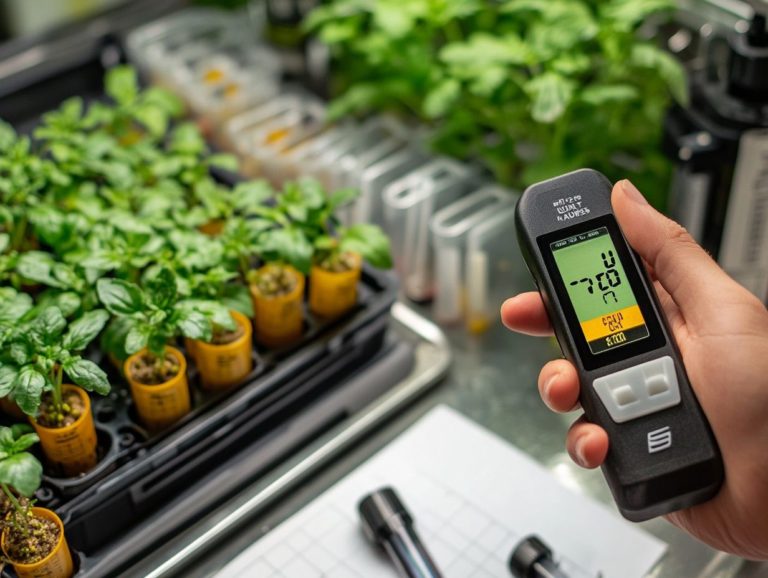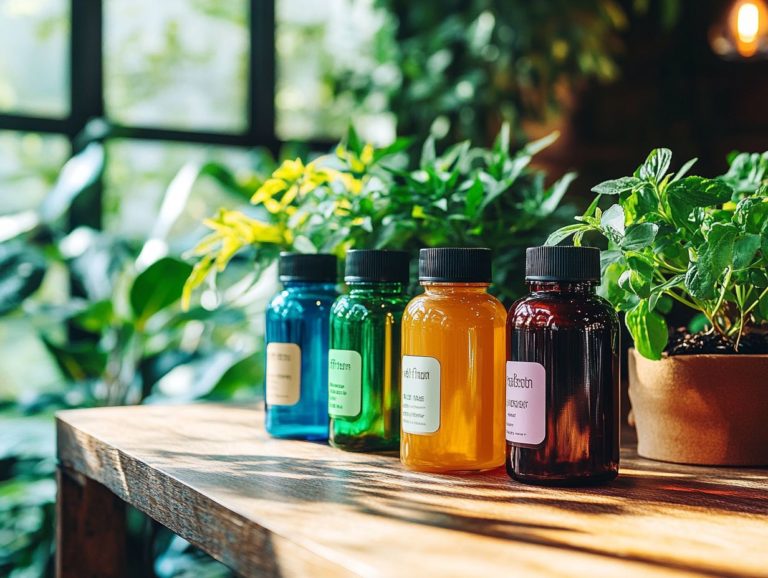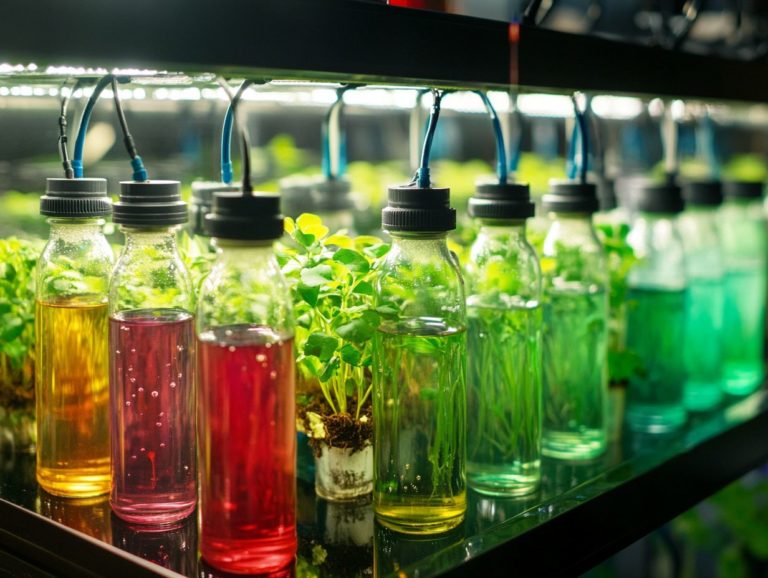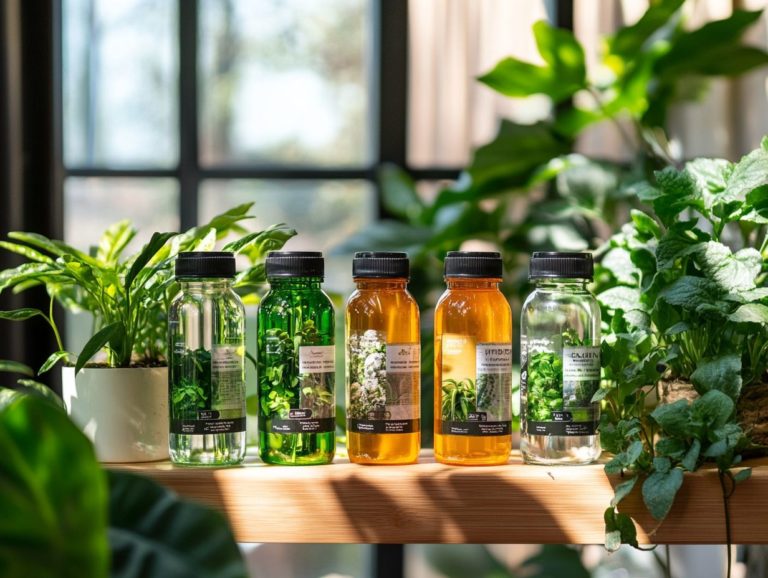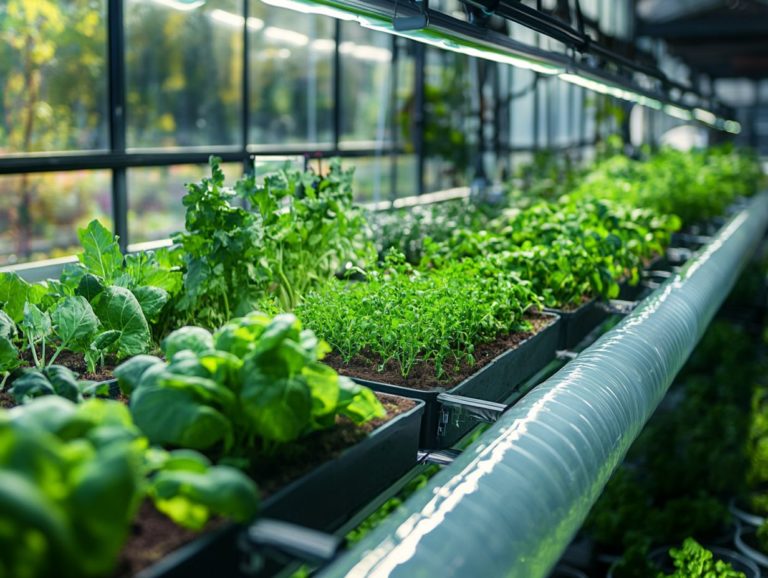5 Best Hydroponic Nutrient Recipes
Hydroponic gardening presents an intriguing method to cultivate plants without the use of soil. This technique relies entirely on nutrient-rich water to nourish them.
Grasping the appropriate nutrient solutions is vital for ensuring your plants thrive. Whether you’re nurturing leafy greens, vibrant flowers, or delicious fruits, this article delves into five essential hydroponic nutrient recipes, meticulously designed for specific growth stages and plant requirements.
You’ll also discover how to create a balanced nutrient mix, identify the essential nutrients your plants crave, and steer clear of common pitfalls that can hinder your progress.
Immerse yourself in this guide to unlock the secrets of successful hydroponic gardening!
Contents
- Key Takeaways:
- 1. Basic Nutrient Solution for Vegetative Growth
- 2. High Nitrogen Nutrient Solution for Leafy Greens
- 3. Balanced Nutrient Solution for Fruit-Bearing Plants
- 4. Low Nitrogen Nutrient Solution for Flowering Plants
- 5. Customized Nutrient Solution for Specific Plant Needs
- What Is Hydroponic Gardening and How Does It Work?
- What Are the Essential Nutrients for Plants in Hydroponic Systems?
- How Can One Create a Balanced Nutrient Solution for Hydroponic Plants?
- What Are the Different Types of Hydroponic Nutrient Recipes?
- How Can One Determine the Right Nutrient Solution for Their Plants?
- What Are Some Common Mistakes to Avoid When Mixing Hydroponic Nutrient Solutions?
- Frequently Asked Questions
- What are the top 5 best hydroponic nutrient recipes?
- What is the General Hydroponics Flora Series nutrient recipe?
- How do I mix the Fox Farm Liquid Nutrient Trio Formula?
- What is the Advanced Nutrients Bloom nutrient recipe?
- Can I use Botanicare Pure Blend Pro in both the vegetative and flowering stages?
- How often should I change my Dyna-Gro nutrient solution?
Key Takeaways:
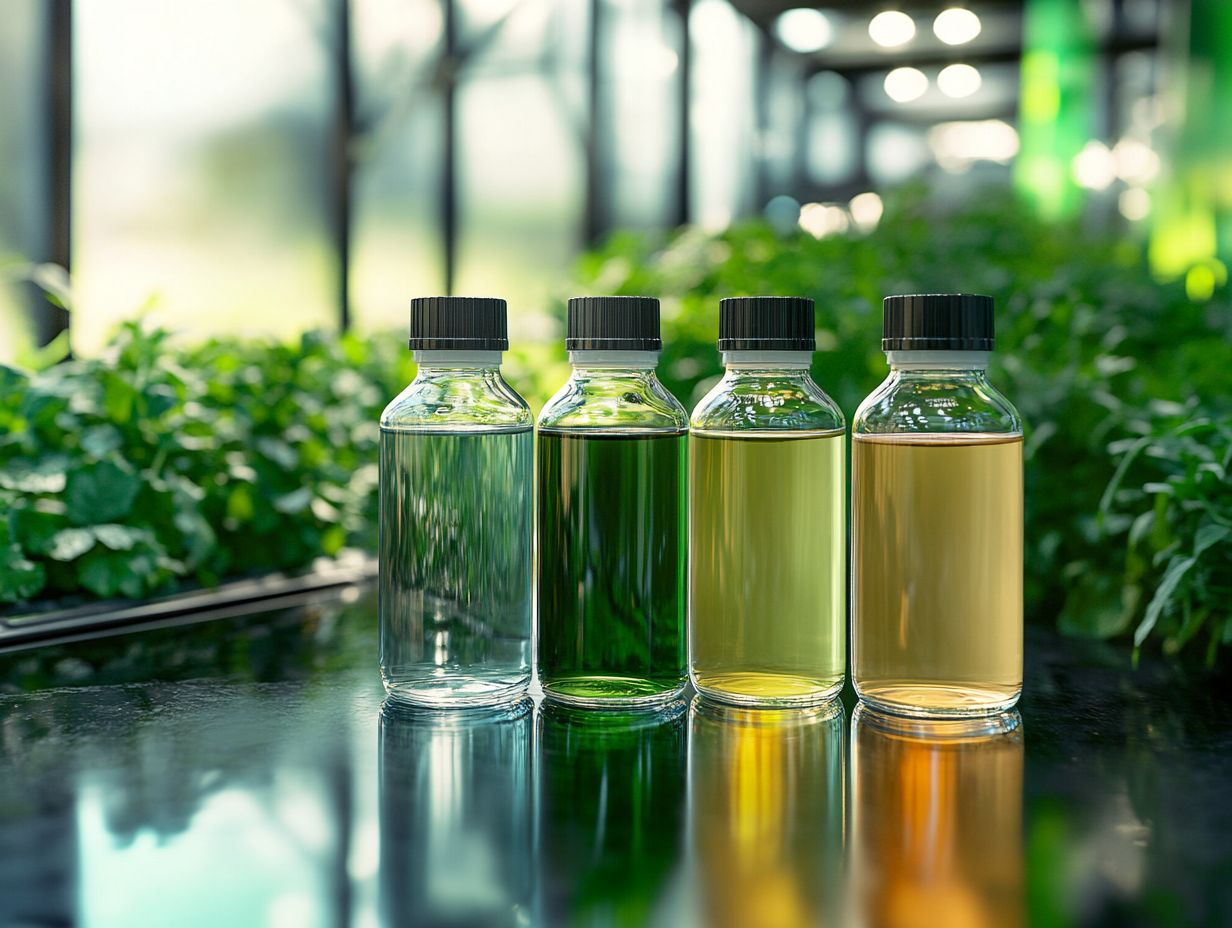
- Ensure proper growth with a basic nutrient solution for vegetative plants.
- Maximize leafy green production with a high nitrogen nutrient solution.
- Boost fruit production with a balanced nutrient solution for fruit-bearing plants.
1. Basic Nutrient Solution for Vegetative Growth
A solid nutrient solution is essential for nurturing healthy, robust plants in hydroponic systems. This is especially true for crops like lettuce and tomatoes.
This solution typically includes key nutrients such as magnesium sulfate and calcium nitrate. These elemental salts lay the groundwork for optimal growth.
Without a proper nutrient solution, your plants may suffer from deficiencies that can stunt their development and diminish their yield potential. Understanding the components and mixing methods of a nutrient solution is vital for anyone serious about hydroponics.
A well-balanced nutrient mix ensures your plants receive the right amounts of nitrogen, phosphorus, and potassium, which are crucial for leaf development and overall vigor. The preparation process often involves dissolving dry fertilizers in water. You can achieve this using techniques like the stir and dissolve method or a mixing tank to ensure consistency.
For those committed to hydroponics, using complete fertilizers can simplify nutrient management. These mixes provide a comprehensive blend that includes both micronutrients and macronutrients, minimizing the guesswork in maintaining an optimal solution.
Master these strategies to boost your plant health and maximize yields! You’ll be on your way to an amazing fruitful harvest!
2. High Nitrogen Nutrient Solution for Leafy Greens
A high-nitrogen nutrient solution is especially advantageous for cultivating leafy greens like hydroponic lettuce and spinach. Nitrogen is essential for fostering lush, vibrant foliage.
By incorporating specific nitrogen sources such as potassium nitrate and ammonium nitrate into your nutrient solution, you can achieve the perfect balance for optimal growth. Potassium nitrate delivers both nitrogen and potassium, boosting overall plant health, while ammonium nitrate provides a readily available nitrogen source.
For these leafy greens, the ideal nitrogen concentration typically falls between 150 to 200 ppm. This promotes vigorous foliage development. Keep in mind that factors like pH levels, temperature, and root zone conditions can significantly impact nitrogen uptake, ensuring your plants not only thrive but also yield a crop that s rich in nutrients and flavor.
3. Balanced Nutrient Solution for Fruit-Bearing Plants
Creating a balanced nutrient solution for your fruit-bearing plants, like hydroponic tomatoes, is essential for achieving optimal growth and fruit quality. This balanced solution provides the necessary macronutrients and micronutrients in the right proportions.
Understanding the specific ratios of nitrogen, phosphorus, and potassium commonly known as NPK is crucial. For example, during the vegetative stage, tomatoes thrive with a higher nitrogen ratio, typically around 3-1-2. As your plants transition into the fruiting stage, this ratio shifts to a more balanced 2-1-3, which promotes robust fruit development.
Including micronutrients such as magnesium, calcium, and iron in appropriate amounts can significantly enhance plant health and productivity. By referring to various nutrient recipes specifically tailored for your crops, you can fine-tune your solutions to ensure that each plant’s unique needs are met. To master this process, check out how to mix hydroponic nutrients like a pro, maximizing your yield with finesse.
4. Low Nitrogen Nutrient Solution for Flowering Plants
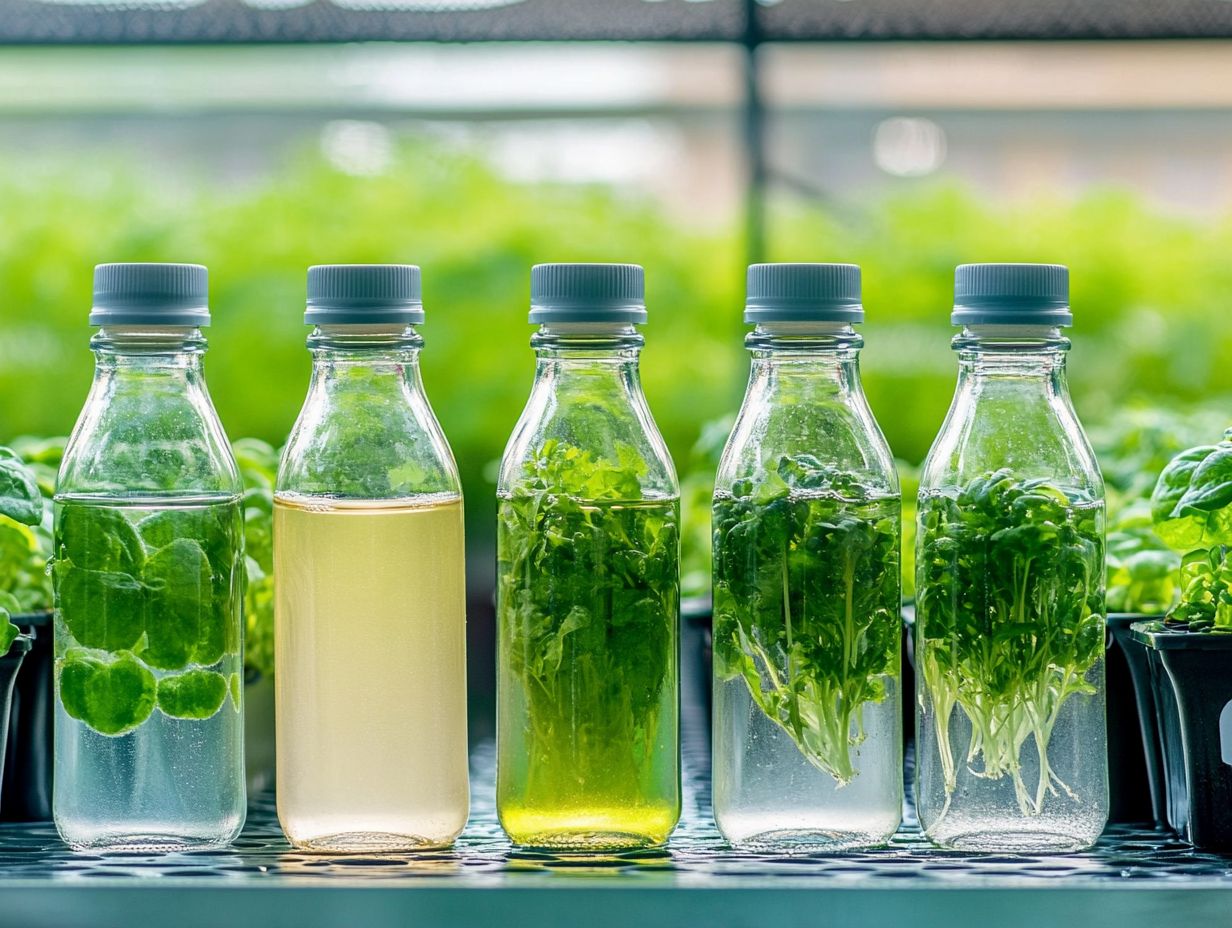
A low nitrogen nutrient solution is tailored specifically for flowering plants, ensuring they get the perfect nutrients for thriving blooms! This precise formulation is vital during the transition from vegetative growth to flowering. A plant’s needs change dramatically at this stage.
You’ll find that adequate levels of phosphorus are essential for boosting flower production. An excess of nitrogen can result in lush foliage at the expense of those beautiful blooms.
Incorporating magnesium sulfate in optimal concentrations supports chlorophyll production, improving light absorption, which is crucial for energy during flowering. By making these thoughtful nutrient adjustments, you can expertly guide your plants through this crucial transformation, leading to vibrant blossoms that flourish beautifully.
5. Customized Nutrient Solution for Specific Plant Needs
A customized nutrient solution tailored to the specific needs of your plants can significantly enhance growth and productivity. This makes it essential for hydroponic gardeners like you who strive for optimal results across various crops.
To achieve this, it s crucial to understand the unique nutrient needs of each plant species alongside the environmental conditions in which they flourish. By conducting regular foliar analyses (testing the leaves for nutrients), you can pinpoint any nutrient deficiencies in your plants.
This allows you to adjust the nutrient concentration in your solutions with precision. This proactive approach ensures that each plant receives the essential nutrients it requires at different growth stages.
It also helps you avoid over-fertilization, which can have harmful effects. Through diligent monitoring and adjustments based on foliar health, you can optimize your nutrient solutions, leading to robust plant development and impressive yields.
What Is Hydroponic Gardening and How Does It Work?
Hydroponic gardening is a groundbreaking approach that enables you to grow plants without soil. It uses hydroponic systems that deliver nutrient solutions directly to the roots. This method not only promotes rapid growth but also yields higher harvests.
By adopting this innovative technique, you can make the most of your space while conserving water. This makes it an appealing choice whether you re tending to a home garden or operating a commercial agricultural venture.
By controlling nutrient concentration and environmental factors, you can optimize plant health and productivity, all while sidestepping common soil-related challenges like pests and diseases.
Historically, hydroponics dates back to ancient civilizations that understood the advantages of cultivating plants in water. Over the years, this technique has evolved significantly, aided by technological advancements and a deeper comprehension of plant physiology.
In contrast to traditional soil-based methods, hydroponic systems utilize a meticulously balanced nutrient solution that delivers essential macro and micronutrients directly to the roots. Unlike soil, where composition can be unpredictable, hydroponics allows for precise management of nutrient ratios, pH levels, and water conditions. For those interested in urban gardening, exploring 5 hydroponic solutions can provide innovative ways to grow plants in limited spaces.
This precision leads to enhanced growth rates and opens the door to year-round cultivation, especially in controlled environments like greenhouses.
What Are the Essential Nutrients for Plants in Hydroponic Systems?
Plants in hydroponic systems need essential nutrients, which include macronutrients and micronutrients. These nutrients are crucial for their health, growth, and productivity without soil.
Macronutrients like nitrogen (N), phosphorus (P), and potassium (K) are fundamental for vital processes such as photosynthesis, energy transfer, and root development. Nitrogen is key for leaf growth and chlorophyll production. Phosphorus supports root formation and flower development, while potassium regulates water uptake and enzyme function.
Micronutrients, such as copper sulfate, manganese sulfate, and zinc sulfate, also play significant roles in plant well-being. For example, copper is essential for photosynthesis, manganese aids in chlorophyll formation, and zinc is vital for hormone production.
Don’t wait for stunted growth! Act now to ensure your plants get the nutrients they need. If any of these nutrients are deficient, you could see impaired functioning and lower yields. Using complete fertilizers is essential for optimal plant health.
How Can One Create a Balanced Nutrient Solution for Hydroponic Plants?
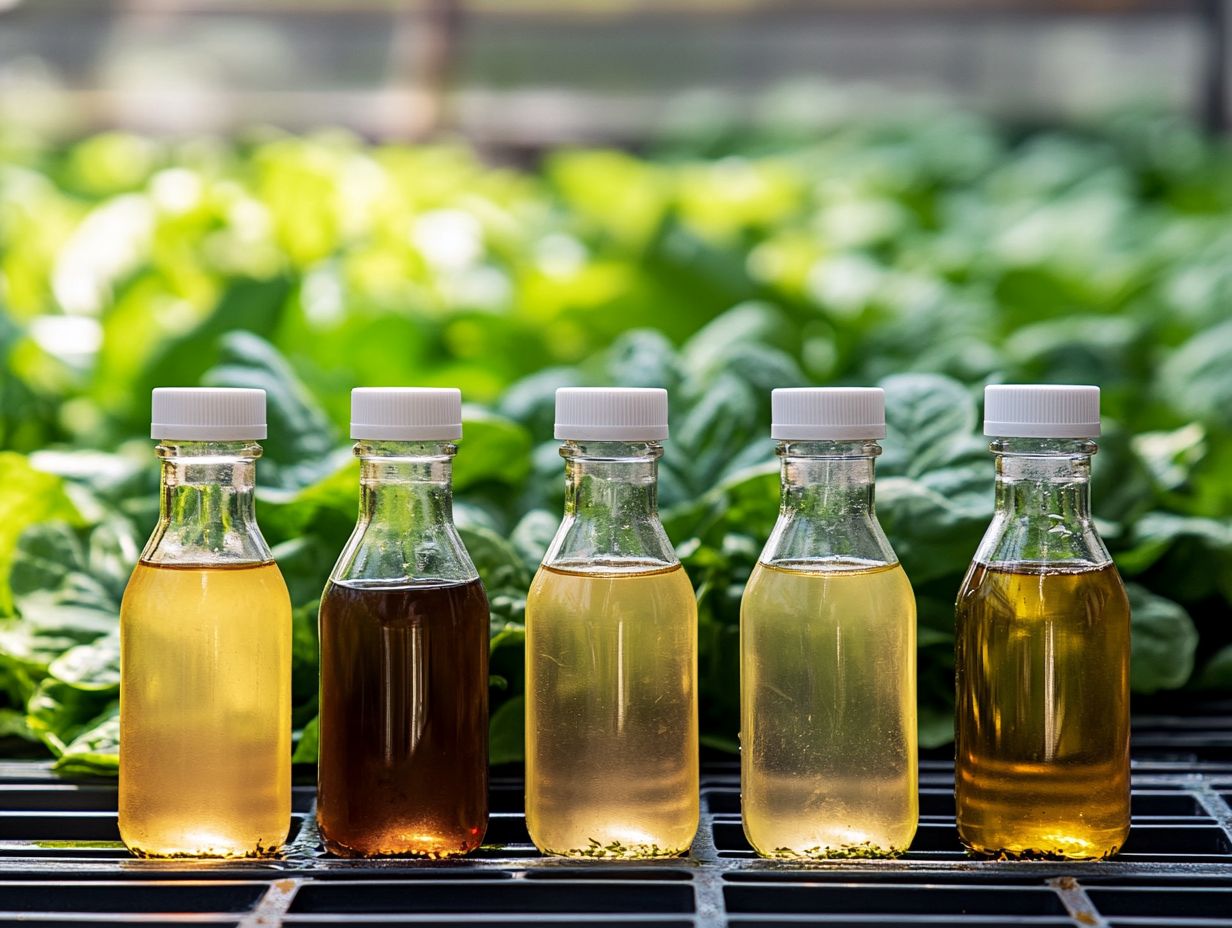
Creating a balanced nutrient solution is an exciting challenge that can lead to thriving plants! To achieve this, you must understand what your plants need. Mix the right mineral compounds to create the perfect nutrient blend.
This journey starts with assessing your plants’ growth stages. Their nutritional requirements evolve from germination to flowering and fruiting. It’s crucial to calculate the correct nutrient ratios, ensuring that macronutrients like nitrogen, phosphorus, and potassium are aligned with essential micronutrients such as magnesium and iron. For beginners, exploring the top hydroponic fertilizers can provide valuable guidance in this process.
Utilizing tools like digital pH testers and TDS meters will help you achieve precise measurements. Whether you hand mix or use a pump, different techniques can provide the uniformity your solution needs.
This level of attention to detail ultimately paves the way for optimal growth and yield in your hydroponic endeavors.
What Are the Different Types of Hydroponic Nutrient Recipes?
Many hydroponic nutrient recipes are available to meet the unique needs of various plants. Popular options include Modified Sonneveld s solution and the Chem-Gro formula, both crafted to offer optimal nutrient levels.
These recipes provide essential macro and micronutrients in precise ratios, fostering healthy growth during every stage, from seedling to flowering. For example, during the vegetative stage, a higher nitrogen content promotes lush foliage and robust root development. To further enhance your gardening efforts, consider the top 5 hydroponic growing systems for beginners. Conversely, increasing potassium and phosphorus during the fruiting stage enhances yield and improves fruit quality.
Choosing the wrong recipe can lead to nutrient imbalances that hinder growth. Growers often need to adjust recipes based on plant responses, environmental conditions, and specific growth goals. For optimal results, understanding hydroponic nutrient solutions is essential. This fine-tuning process allows for maximum effectiveness.
How Can One Determine the Right Nutrient Solution for Their Plants?
Determining the right nutrient solution requires careful analysis of your plants’ specific needs, environmental conditions, and growth stages. You might find it helpful to use tools like foliar analysis to accurately assess nutrient concentration.
Beyond visual inspections and growth assessments, you can enhance your understanding through laboratory tests. Consider soil samples and tissue analysis to gain insight into nutrient availability. These evaluations help identify deficiencies or excesses, guiding necessary adjustments.
Understanding the developmental phase of your plants is crucial. By tailoring nutrient applications to meet specific requirements for flowering or fruiting stages, you can ensure that your plants thrive.
What Are Some Common Mistakes to Avoid When Mixing Hydroponic Nutrient Solutions?
Mixing hydroponic nutrient solutions can be easy. Common mistakes may disrupt nutrient balances and harm your plants’ health and growth.
To steer clear of these pitfalls, it s essential to take precise measurements and pay attention to solubility factors. Many growers overlook the differing nutrient needs of various plant species, resulting in inadequate nutrient provision.
For example, a leafy green has different nutrient composition requirements than a fruiting plant. Regularly testing the pH and electrical conductivity of your solution is crucial.
Electrical Conductivity: This measures how well your solution can conduct electricity, indicating nutrient concentration.
pH: This measures how acidic or alkaline your solution is, affecting nutrient availability.
Monitor the growth phases of your plants. This helps you make personalized nutrient adjustments, ensuring optimal uptake and fostering vigorous growth.
Frequently Asked Questions
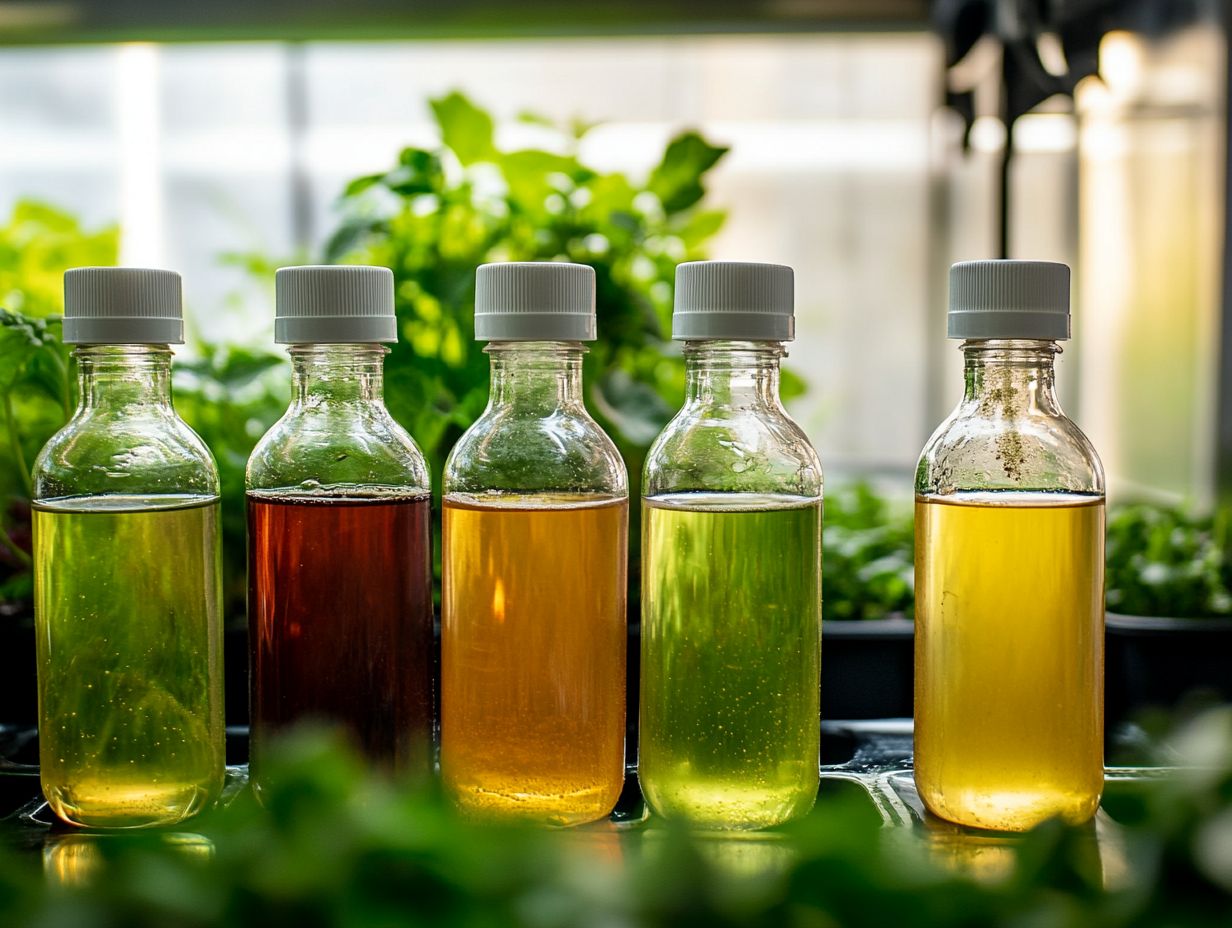
What are the top 5 best hydroponic nutrient recipes?
The top 5 hydroponic nutrient recipes are:
- General Hydroponics Flora Series
- Fox Farm Liquid Nutrient Trio Formula
- Advanced Nutrients Bloom
- Botanicare Pure Blend Pro Grow and Pro Bloom
- Dyna-Gro Foliage-Pro and Bloom
What is the General Hydroponics Flora Series nutrient recipe?
The General Hydroponics Flora Series nutrient recipe includes FloraGro, FloraMicro, and FloraBloom. This balanced formula provides essential nutrients for all stages of plant growth.
How do I mix the Fox Farm Liquid Nutrient Trio Formula?
To mix the Fox Farm Liquid Nutrient Trio Formula, start with 1 teaspoon of Big Bloom per gallon of water. Then, add 1 teaspoon of Grow Big and 1 teaspoon of Tiger Bloom. Adjust the amounts based on your plants’ needs and growth stage.
What is the Advanced Nutrients Bloom nutrient recipe?
The Advanced Nutrients Bloom nutrient recipe includes pH Perfect Grow, Micro, and Bloom. These nutrients are formulated specifically for hydroponic systems and provide a complete profile of essential macro and micronutrients.
Can I use Botanicare Pure Blend Pro in both the vegetative and flowering stages?
Yes, Botanicare Pure Blend Pro can be used in both the vegetative and flowering stages. The Grow formula is ideal for the vegetative stage, while the Bloom formula is specifically formulated for the flowering stage.
How often should I change my Dyna-Gro nutrient solution?
Dyna-Gro nutrient solution should be changed every 7-14 days, depending on the size and type of plants you are growing. Regularly check the pH and nutrient levels to keep your plants thriving and growing robustly!

